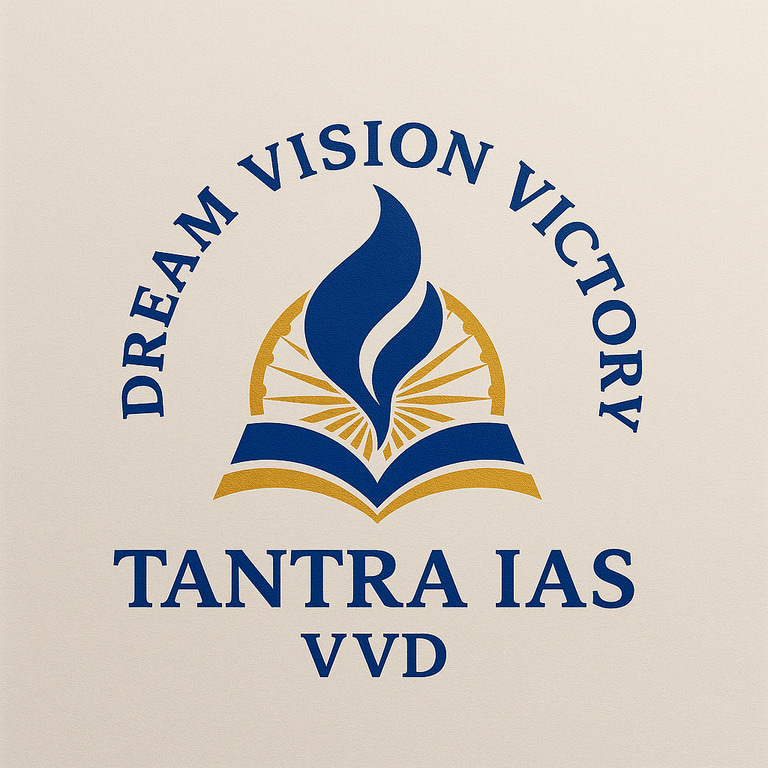SPURIOUS COUGH SYRUPS & INDIA’S DRUG REGULATION CRISIS.
Theme: Health Sector | Governance | Regulatory Mechanisms | Ethics in Public Administration.
🧬 Context
Deaths of 14 children in Madhya Pradesh and Rajasthan (2025) due to contaminated cough syrups once again exposed gaps in India’s drug quality control system.
This follows a disturbing pattern — similar tragedies in Gambia (2022) and Uzbekistan (2023) linked to diethylene glycol (DEG) contamination in Indian-made syrups.
⚙️ The Issue
🔹 Toxic Ingredient: Diethylene glycol (DEG) — a solvent that causes acute kidney failure when consumed.
🔹 Regulatory Failure: Inadequate testing, poor coordination between state drug controllers and CDSCO (Central Drugs Standard Control Organisation).
🔹 Global Fallout: Export bans, reputational damage to India’s pharma sector.
🔹 Industry Paradox: India — “pharmacy of the world” — yet faces rising cases of spurious or substandard drugs domestically and abroad.
📊 Key Facts & Data
India supplies 40% of generic drugs to the US and 20% of global generics.
DEG-related deaths: Over 300 worldwide (past 30 years).
WHO flagged critical lapses in drug testing & traceability post-COVID.
Over 8% of India’s sampled drugs failed quality tests (CDSCO 2024 data).
🧭 UPSC Mains Relevance
GS Paper 2:
Issues relating to health, regulation & governance.
Role of statutory bodies (CDSCO, NPPA).
Accountability & ethical governance in public administration.
GS Paper 3:
Biotechnology & health research applications.
Industrial policy and pharma exports.
GS4 (Ethics):
Conflict between profit motive & public safety.
Ethical responsibility of regulators and manufacturers.
💡 Significance
✅ Urgent need for uniform national drug regulatory standards.
✅ Strengthen Central–State coordination for real-time product testing.
✅ Adoption of QR-based traceability for every medicine batch.
✅ Empower Drug Regulatory Authority of India (DRAI) with statutory autonomy.
✅ Ensure ethical accountability within the pharma sector.
⚖️ Challenges
⚠️ Fragmented federal structure for drug control.
⚠️ Weak enforcement & staff shortages in testing labs.
⚠️ Overdependence on exports — neglect of domestic oversight.
⚠️ Public trust erosion in “Make in India” pharma products.
🧩 Conclusion
India’s image as the “pharmacy of the world” cannot rest on low-cost mass production alone. Quality, ethics, and transparency must form the new foundation of Pharma 2.0 — where public health trumps profit.
🧠 Topper’s Toolkit (Value Add)
Keyword: “Pharma without ethics is a prescription for disaster.”
Quote: “Regulation is not a hurdle to innovation — it is its moral compass.”
Diagram Idea: Flowchart → Drug Manufacture → Testing → Export → Regulatory Failure → Policy Reform.
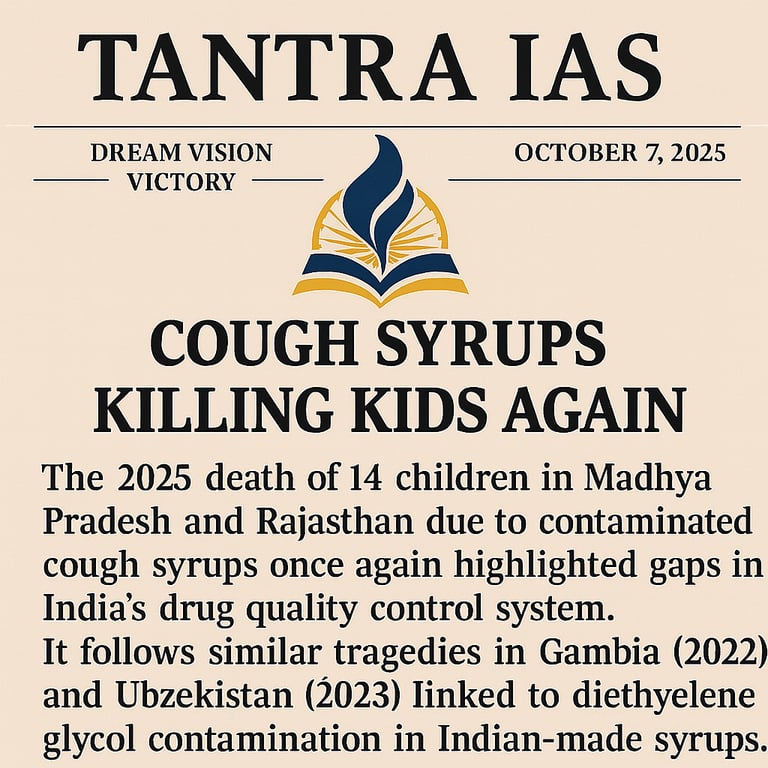

💧 WATER CONSERVATION PRIORITISED UNDER MGNREGA
Theme: Government Policies & Interventions | Rural Development | Sustainable Water Management.
📰 Context
The Central Government has amended the Schedule of the Mahatma Gandhi National Rural Employment Guarantee Act (MGNREGA), 2005, to prioritise water conservation and harvesting works in rural areas.
The Ministry of Rural Development (MoRD) notified this policy change on September 23, 2025.
⚙️ Key Highlights of the Amendment
🔹 New Focus: Rural water assets — check dams, percolation tanks, ponds, and recharge wells.
🔹 Minimum Share: 60% of MGNREGA works must now relate to agriculture and water conservation.
🔹 Groundwater Stress Priority: Over-exploited and semi-critical blocks will receive preferential funding.
🔹 Integrated Implementation: Linked with the Jal Shakti Abhiyan, Atal Bhujal Yojana, and PM Krishi Sinchai Yojana.
💦 Objectives
✅ Strengthen water resilience and sustainable rural livelihoods.
✅ Reduce dependence on monsoons and enhance farm productivity.
✅ Create durable community assets to tackle drought and climate stress.
✅ Promote convergence between environmental regeneration and employment.
🧭 UPSC Mains Relevance
GS Paper 2: Welfare schemes for vulnerable sections; issues in implementation.
GS Paper 3: Conservation of natural resources, Environmental impact and rural development synergy, Climate change adaptation through water management.
🎯 UPSC Prelims Pointers
Implementing Ministry: Ministry of Rural Development (MoRD).
Legal Backing: Section 16, Schedule I of the MGNREGA, 2005.
Key Classification:
Over-exploited blocks → >100% groundwater extraction.
Critical blocks → 90–100%.
Semi-critical → 70–90%.
MGNREGA Asset Types: Water harvesting, afforestation, flood control, and irrigation channel repair.
💡 Significance
✅ Aligns wage employment with long-term resource creation.
✅ Tackles India’s water crisis — over 70% districts water-stressed.
✅ Encourages decentralised, people-led water management.
✅ Strengthens climate adaptation under LiFE (Lifestyle for Environment).
⚖️ Challenges
⚠️ Skill & monitoring gaps at panchayat level.
⚠️ Delays in fund release and capacity building.
⚠️ Need for transparency in work prioritisation.
🧩 Conclusion
The amendment transforms MGNREGA into a “Water Security Employment Mission”, ensuring that livelihood generation and ecological balance go hand in hand — a critical step toward climate-smart rural governance.
🧠 Topper’s Toolkit (Value Add)
Keyword: “MGNREGA 2.0 — from Wage Security to Water Security.”
Quote: “Water is the foundation of both life and livelihoods.”
Diagram Idea: Flow → MGNREGA Amendment → Water Projects → Livelihood + Sustainability + Resilience.
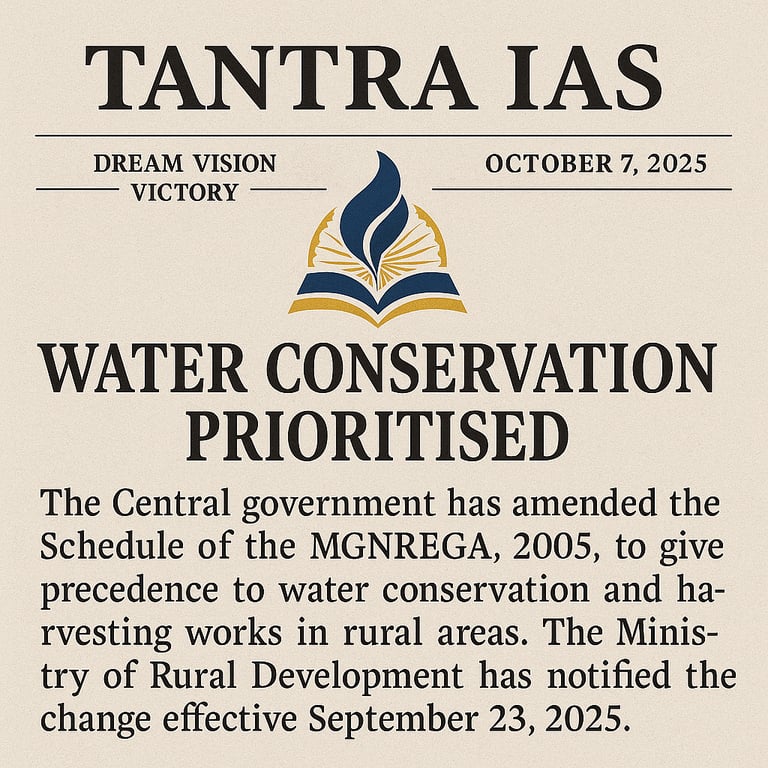

2025 NOBEL PRIZE IN MEDICINE
Theme: Science & Technology | Biotechnology | Human Physiology
🧠 Context
The 2025 Nobel Prize in Physiology or Medicine was awarded to Mary E. B. Runkow (USA), Frederick Ramsdell (USA), and Shimon Sakaguchi (Japan) for discovering Regulatory T Cells (Tregs) — the “police cells” that prevent the immune system from attacking the body’s own tissues.
⚙️ Key Discovery
🔹 Regulatory T Cells (Tregs): A subset of white blood cells that maintain immune tolerance — preventing the immune system from damaging self-tissues.
🔹 Gene Identified: FOXP3 — the master gene that controls Treg development.
🔹 Function: Tregs suppress overactive immune responses that can cause autoimmune diseases such as type-1 diabetes, rheumatoid arthritis, multiple sclerosis, and lupus.
🔹 Mechanism: They act as “brakes” of the immune system — balancing attack and restraint.
🔍 UPSC Mains Relevance (GS Paper 3)
Science & Technology: Developments in biotechnology & health research.
Health Sector: Understanding autoimmune disorders & immune regulation.
Applications: Future scope in immunotherapy, organ transplantation, and cancer treatment.
🎯 UPSC Prelims Relevance
Possible MCQ Angles:
1️⃣ 2025 Nobel Prize awarded for discovery of Regulatory T Cells (Tregs).
2️⃣ FOXP3 gene is associated with development of immune tolerance.
3️⃣ Function of Tregs → prevent immune system from attacking self-tissues.
4️⃣ Shimon Sakaguchi first identified Tregs in the 1990s.
5️⃣ Autoimmune diseases arise when immune tolerance fails.
💡 Significance
✅ Deeper understanding of immune balance → better treatment of autoimmune diseases.
✅ Foundation for next-generation cell-based immunotherapies.
✅ May lead to customised immune modulation in cancer & organ transplant medicine.
✅ Reinforces India’s focus on immunology under National Biotech Development Strategy 2025.
⚖️ Ethical Dimensions (GS4 Link)
Balancing medical innovation with safety & equity.
Ethical trials in gene therapy & immune modulation.
Access to immunotherapies in low-income nations.
🧩 Conclusion
This Nobel-winning discovery unravels one of biology’s deepest puzzles — how the immune system knows when to fight and when to stand down. It opens the path to curing autoimmune diseases through precision immunology.
🧠 Topper’s Toolkit (Value Add)
Keyword: “Immune tolerance through Regulatory T cells.”
Quote: “The immune system’s greatest strength is knowing its limits.”
Diagram Idea: Immune balance — Active T Cells vs Regulatory T Cells.
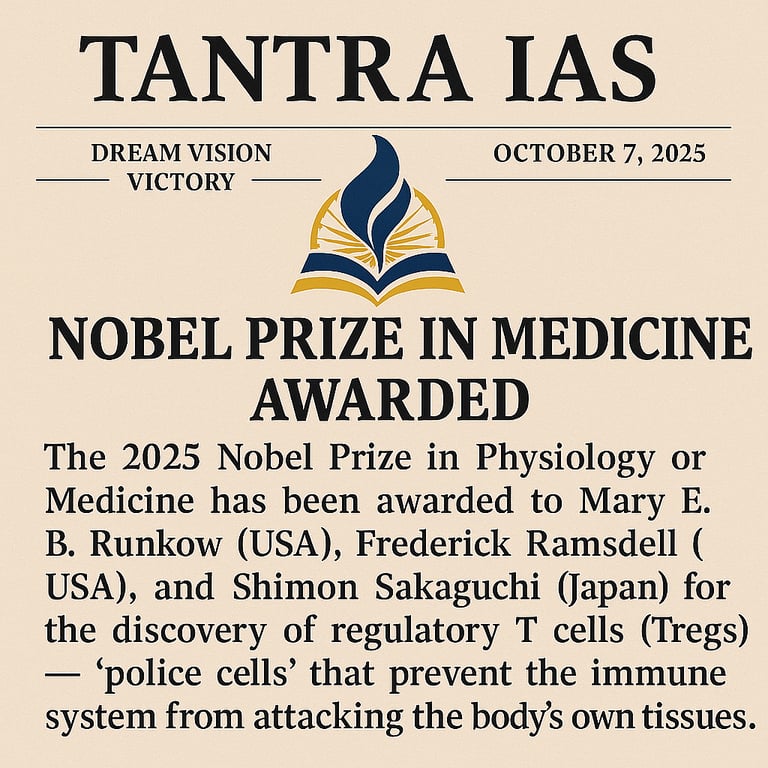

🚀 GAGANYAAN: INDIA’S LEAP INTO SPACE
Theme: Science & Technology | Indigenisation | Space Technology
🌍 Context
Gaganyaan Mission, led by ISRO, aims to send a 3-member Indian crew into low Earth orbit (400 km) for 3 days and bring them safely back to Earth. It represents India’s entry into the elite group of nations with human spaceflight capability — after the USA, Russia, and China.
🛰️ Features
🔹 Crew Module (CM): Pressurised capsule carrying astronauts with life support and emergency systems.
🔹 Service Module (SM): Supplies power, propulsion, and thermal control.
🔹 Launch Vehicle: HLVM3 (Human-rated LVM3).
🔹 Training: Astronauts trained in India and Russia; Gaganyaan Astronaut Training Facility in Bengaluru.
🔹 Safety Systems: Crew Escape System (CES) tested successfully.
🔹 Mission Partners: ISRO, DRDO, HAL, BEL, IN-SPACe, and private tech firms.
⚙️ Objectives
✅ Validate indigenous spaceflight capability.
✅ Strengthen aerospace R&D, robotics, and life-support systems.
✅ Inspire youth & promote STEM innovation.
✅ Build international collaboration for deep space missions (e.g., LUPEX, Chandrayaan-Next).
🧭 UPSC Mains Relevance (GS Paper 3):
Science & Technology: Achievements of Indians in space technology.
Indigenisation: Development of indigenous launch vehicles & space tech.
Security: Strategic & scientific self-reliance under “Atmanirbhar Bharat”.
🎯 UPSC Prelims Relevance:
Possible MCQ Angles:
1️⃣ Gaganyaan involves Human-rated LVM3 launch vehicle.
2️⃣ Crew Module designed for re-entry & safe landing in Indian Ocean.
3️⃣ Mission partners include ISRO, DRDO, HAL, BEL.
4️⃣ Training collaborations with Russia’s Gagarin Cosmonaut Training Center.
5️⃣ HLVM3 stands for Human Launch Vehicle Mark-3.
💡 Significance
✅ Positions India as a global space power.
✅ Boosts indigenous innovation & manufacturing.
✅ Expands private sector & academia participation in space ecosystem.
✅ Strengthens “IndiaAI” & advanced robotics integration for future missions.
⚖️ Challenges
⚠️ High cost & complexity (~₹9,000 crore).
⚠️ Astronaut safety, life support validation, re-entry precision.
⚠️ Maintaining global cooperation amid strategic competition.
🧩 Conclusion
Gaganyaan is not just a space mission — it’s India’s declaration of scientific confidence, technological maturity, and visionary ambition.
🧠 Topper’s Toolkit
Keyword: “Human-rated launch vehicle.”
Quote: “Space exploration is the ultimate expression of human curiosity and courage.”
Diagram Idea: Gaganyaan architecture — Crew Module, Launch Vehicle, Orbital Path.
UPSC PYQ:
Q. Consider the following space missions: (UPSC PRE-2025)
I. Axiom-4
II. SpaDeX
III. Gaganyaan
How many encourage mesogravity research?
Only one
Only two
All three
None
ANSWER: Option 3: All three.
Explanation: All three missions — Axiom-4, SpaDeX, and Gaganyaan — encourage mesogravity (microgravity/low-gravity) research.
Axiom-4: Conducts multiple microgravity experiments aboard the International Space Station (ISS) related to human physiology and space biotechnology.
SpaDeX (Space Docking Experiment): Though primarily a technology demonstrator for autonomous docking, it also carries several payloads designed for experiments utilizing the microgravity environment in orbit.
Gaganyaan: India’s human spaceflight programme aims to facilitate a range of microgravity experiments in life sciences, material sciences, and space medicine through its orbital module.
✅ Final Answer: 3
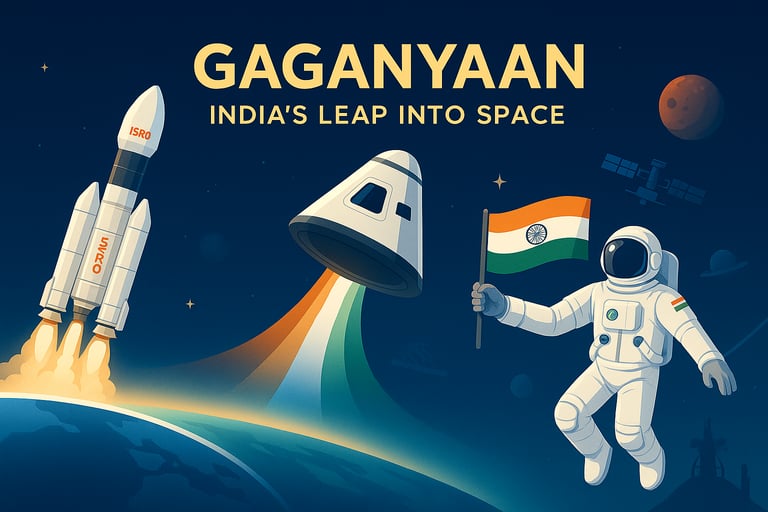

DAILY UPDATES
UPSC CURRENT AFFAIRS
MISSION SUDARSHAN CHAKRA
Theme: Internal Security | Science & Technology | Defence Infrastructure
⚡ Context
India’s Mission Sudarshan Chakra will establish a nationwide multi-layered air defence shield by linking 6,000–7,000 radars, satellites, and directed-energy weapons (DEWs). It represents a landmark move towards an indigenous, technology-driven defence ecosystem.
⚙️ Key Features
🔹 Layered Shield: Tracks aerial threats beyond the horizon through an integrated radar-satellite-AI network.
🔹 Satellites: Enable real-time surveillance of hostile launches and incursions.
🔹 Directed Energy Weapons (DEWs): Laser-based systems to neutralise enemy drones and missiles.
🔹 Integration: Combines radars, DEWs, anti-drone systems, and air-defence guns.
🔹 Institutions Involved: DRDO, ISRO, BEL, armed forces, paramilitary, and defence PSUs under a unified Strategic Coordination Framework.
🧭 UPSC Mains Relevance (GS Paper 3)
Internal Security: Modernisation of armed forces; defence preparedness.
Science & Technology: Application of lasers, AI, and radar technology in national security.
Indigenisation: “Atmanirbhar Bharat” in defence R&D and production.
🎯 UPSC Prelims Relevance
Possible MCQ Angles:
1️⃣ Mission Sudarshan Chakra is related to → Integrated national air defence shield.
2️⃣ Directed Energy Weapons use → High-energy lasers or microwaves to disable targets.
3️⃣ DEWs differ from conventional missiles as they rely on energy beams, not kinetic projectiles.
4️⃣ Agencies involved → DRDO + ISRO + defence PSUs (BEL, HAL).
5️⃣ Objective: Multi-layered protection against aircraft, drones, and ballistic missiles.
💡 Significance
✅ Boosts national security & technological sovereignty.
✅ Detects and neutralises cross-border aerial threats early.
✅ Strengthens India’s deterrence posture and regional stability.
✅ Builds synergy between civil–military research.
⚖️ Challenges
⚠️ High development cost & tech complexity.
⚠️ Cyber-vulnerability of integrated networks.
⚠️ Need for interoperability & unified command.
⚠️ Potential for global weaponisation of space.
🧩 Conclusion
Mission Sudarshan Chakra symbolises India’s transition from reactive defence to proactive deterrence, positioning it among the few nations pursuing energy-based, AI-integrated air-defence systems.
🧠 Topper’s Toolkit (Value-Add)
Keyword: “Layered Air-Defence Architecture.”
Quote: “Technology is the new frontier of sovereignty.”
Diagram Idea: Circular radar-satellite grid showing integration of DEWs, radars & command nodes.
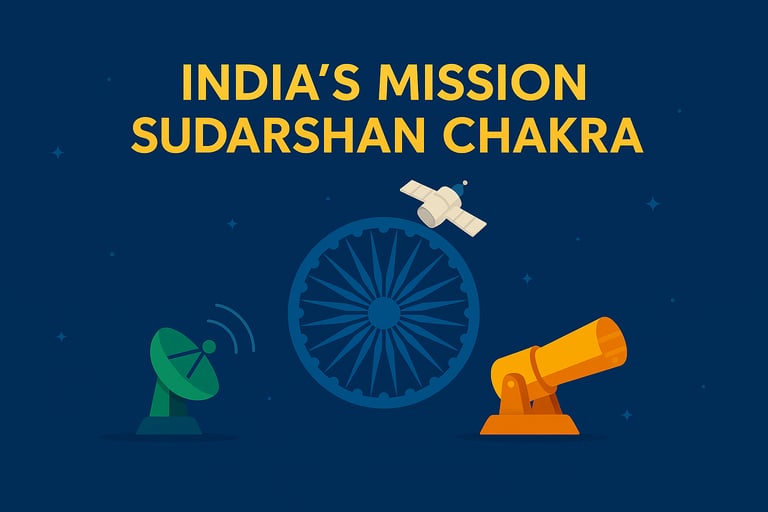

DAILY UPDATES
UPSC CURRENT AFFAIRS
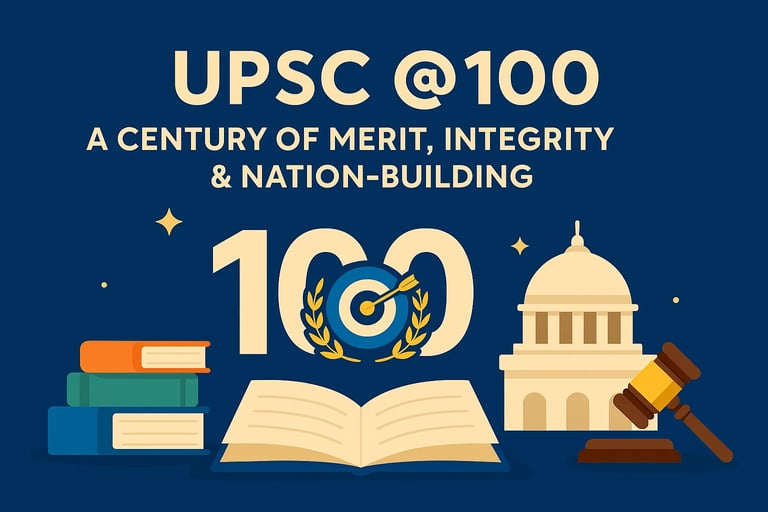

UPSC @100 – From Selection to Transformation
Context:
As UPSC completes 100 years (1925–2025), it stands as India’s longest-surviving symbol of meritocracy, neutrality, and institutional integrity. Its evolution reflects how governance in India has shifted from colonial control to ethical, citizen-centric administration.
Syllabus Mapping:
Prelims:
Indian Polity & Governance → Constitutional Bodies (Articles 315–323)
Current Affairs → Administrative reforms, transparency, recruitment innovations
History → Development of modern civil services
Economy → Public administration, fiscal efficiency, HR reforms
Mains:
GS II: Role & functions of constitutional bodies, reforms in civil services
GS IV: Integrity, impartiality, public service values
Essay: Institutional trust, governance ethics, meritocracy
GS I / GS III (linkages): Administrative evolution, technological governance
